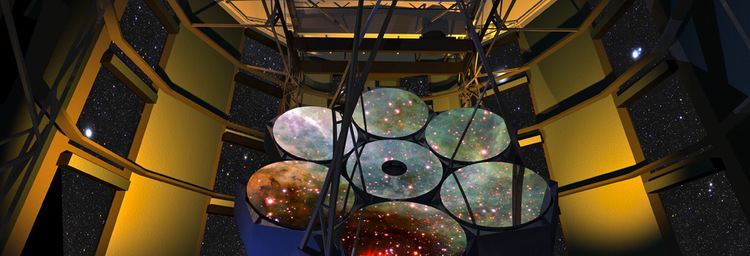Organisation GMT Consortium Built Under construction Diameter 25 m | Altitude 2,516 m (8,255 ft) First light 2021; completion: 2025 | |
 | ||
Wavelength optical and near infrared (320–25000 nm) Similar Thirty Meter Telescope, Las Campanas Observatory, Very Large Telescope, W M Keck Observatory, European Southern Observatory | ||
Giant magellan telescope a perfect mirror
The Giant Magellan Telescope (GMT) is a ground-based extremely large telescope under construction, planned for completion in 2025. It will consist of seven 8.4 m (27.6 ft) diameter primary segments, with the resolving power of a 24.5 m (80.4 ft) primary mirror and collecting area equivalent to a 22.0 m (72.2 ft) one, which is about 368 square meters. The telescope is expected to have the resolving power 10 times greater than the Hubble Space Telescope, and will be the largest optical observatory in the world, at the time of its first light. As of December 2015, four mirrors have been cast and the construction of the summit facility has begun.
Contents
- Giant magellan telescope a perfect mirror
- The biggest eyes on earth building the giant magellan telescope
- Site
- Mirrors
- Comparison
- Organizations
- Status of mirrors
- References

A total of seven primary mirrors are planned, but it will begin operation with four. The $1 billion project is US-led in partnership with Australia, Brazil, and Korea, with Chile as the host country.

The biggest eyes on earth building the giant magellan telescope
Site

The location of the telescope is Las Campanas Observatory, which is also the site of the Magellan Telescopes, some 115 km (71 mi) north-northeast of La Serena, Chile. The site has been chosen as the new instrument's location because of its outstanding astronomical seeing and clear weather throughout most of the year. Moreover, due to the sparsity of population centers and other favorable geographical conditions, the night sky in most of the surrounding Atacama Desert region is not only free from atmospheric pollution, but in addition it is probably one of the places least affected by light pollution, making the area one of the best spots on Earth for long-term astronomical observation. Major site preparation began with the first blast to level the mountain peak on 23 March 2012. In November 2015, construction was started at the site, with a ground-breaking ceremony.
Mirrors

The telescope will use seven of the world's largest mirrors as primary mirror segments, each 8.417 m (27.61 ft) in diameter. These segments will then be arranged with one mirror in the center and the other six arranged symmetrically around it. The challenge is that the outer six mirror segments will be off-axis, and although identical to each other, will not be individually radially symmetrical, necessitating a modification of the usual polishing and testing procedures.

The mirrors are being constructed by the University of Arizona's Steward Observatory Mirror Lab. The casting of the first mirror, in a rotating furnace, was completed on November 3, 2005, but the grinding and polishing were still going on 6½ years later when the second mirror was cast, on 14 January 2012. A third segment was cast in August 2013, and the fourth in September 2015. The casting of each mirror uses 20 tons of E6 borosilicate glass from the Ohara Corporation of Japan and takes about 12–13 weeks. After being cast, they need to cool for about six months.
Polishing of the first mirror was completed in November 2012. As this was an off-axis segment, a wide array of new optical tests and laboratory infrastructure had to be developed to polish the mirror.
The intention is to build seven identical off-axis mirrors, so that a spare is available to substitute for a segment being recoated, a 1–2 week (per segment) process required every 1–2 years. While the complete telescope will use seven mirrors, it is planned to begin operation with four mirrors.
The primary mirror array as a whole will have a focal ratio (focal length divided by diameter) of f/0.71. For an individual segment – being one third that diameter – this results in a focal ratio of f/2.14. The overall focal ratio of the complete telescope will be f/8 and the optical prescription is an aplanatic Gregorian telescope. Like all modern large telescopes it will make use of adaptive optics.
Scientists expect very high quality images due to the very large aperture and advanced adaptive optics. Image resolution should exceed that of the Hubble Space Telescope.
Comparison
The Giant Magellan Telescope is one of a new class of telescopes called extremely large telescopes with each design being much larger than previous telescopes. Other planned extremely large telescopes include the European Extremely Large Telescope and the Thirty Meter Telescope.
Organizations
The project is US-led in partnership with Australia, Brazil, and Korea, with Chile as the host country. The following organizations are members of the consortium developing the telescope.
The Carnegie Observatories office in Pasadena has an outline of the GMT primary mirror array painted in its parking lot. It is easily visible in satellite imagery at 34.15591°N 118.13345°W / 34.15591; -118.13345 (Giant Magellan Telescope outline drawing).
Status of mirrors
There will be a total of seven primary mirrors: One central mirror and six off-axis segments, The mirrors are made of borosilicate glass and have a honeycomb structure below the mirror surface. An adaptive secondary mirror is also designed for the telescope. A spare off-axis segment is also planned (six off-axis and one primary are used as a primary mirror).
